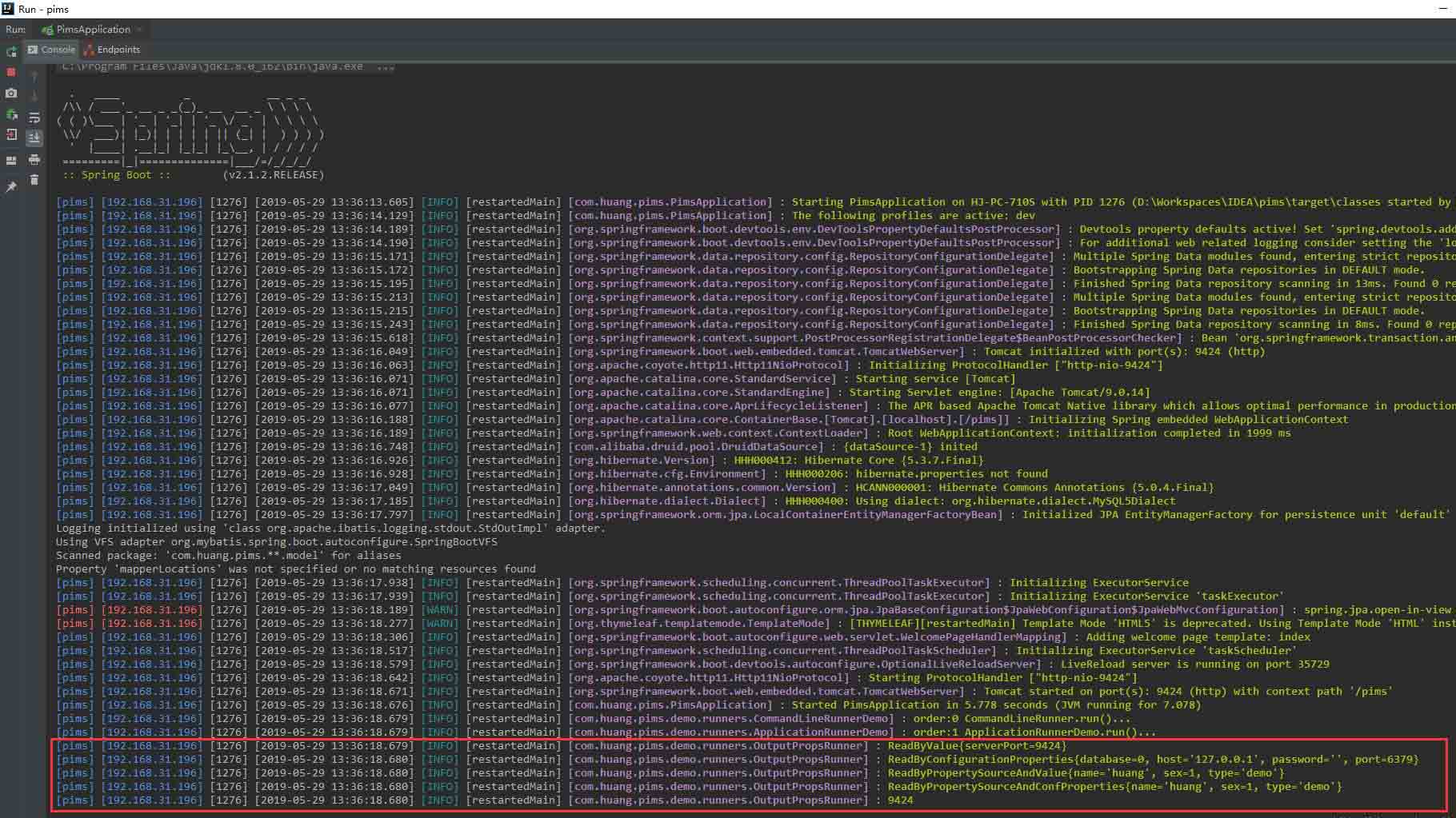关于@PropertySource配置的用法解析
目录
- @PropertySource配置用法
- 功能
- 源码
- 使用示例
- 示例测试
- @PropertySource注解
- 例如
- 示例
@PropertySource配置用法
功能
加载指定的属性文件(*.properties)到 Spring 的 Environment 中。可以配合 @Value 和@ConfigurationProperties 使用。
@PropertySource 和 @Value组合使用,可以将自定义属性文件中的属性变量值注入到当前类的使用@Value注解的成员变量中。
@PropertySource 和 @ConfigurationProperties组合使用,可以将属性文件与一个Java类绑定,将属性文件中的变量值注入到该Java类的成员变量中。
源码
package org.springframework.context.annotation;
import java.lang.annotation.Documented;
import java.lang.annotation.ElementType;
import java.lang.annotation.Repeatable;
import java.lang.annotation.Retention;
import java.lang.annotation.RetentionPolicy;
import java.lang.annotation.Target;
import org.springframework.core.io.support.PropertySourceFactory;
@Target(ElementType.TYPE)
@Retention(RetentionPolicy.RUNTIME)
@Documented
@Repeatable(PropertySources.class)
public @interface PropertySource {
/**
* 属性源的名称
*/
String name() default "";
/**
* 属性文件的存放路径
*/
String[] value();
/**
* 如果指定的属性源不存在,是否要忽略这个错误
*/
boolean ignoreResourceNotFound() default false;
/**
* 属性源的编码格式
*/
String encoding() default "";
/**
* 属性源工厂
*/
Class<? extends PropertySourceFactory> factory() default PropertySourceFactory.class;
}
使用示例
属性文件:demo.properties
demo.name=huang demo.sex=1 demo.type=demo
示例一:@PropertySource + @Value
package com.huang.pims.demo.props;
import org.springframework.beans.factory.annotation.Value;
import org.springframework.context.annotation.PropertySource;
import org.springframework.stereotype.Component;
@Component
@PropertySource(value = {"demo/props/demo.properties"})
public class ReadByPropertySourceAndValue {
@Value("${demo.name}")
private String name;
@Value("${demo.sex}")
private int sex;
@Value("${demo.type}")
private String type;
@Override
public String toString() {
return "ReadByPropertySourceAndValue{" +
"name='" + name + '\'' +
", sex=" + sex +
", type='" + type + '\'' +
'}';
}
}
示例二:@PropertySource 和 @ConfigurationProperties
package com.huang.pims.demo.props;
import org.springframework.boot.context.properties.ConfigurationProperties;
import org.springframework.context.annotation.PropertySource;
import org.springframework.stereotype.Component;
@Component
@PropertySource(value = {"demo/props/demo.properties"})
@ConfigurationProperties(prefix = "demo")
public class ReadByPropertySourceAndConfProperties {
private String name;
private int sex;
private String type;
public void setName(String name) {
this.name = name;
}
public void setSex(int sex) {
this.sex = sex;
}
public void setType(String type) {
this.type = type;
}
public String getName() {
return name;
}
public int getSex() {
return sex;
}
public String getType() {
return type;
}
@Override
public String toString() {
return "ReadByPropertySourceAndConfProperties{" +
"name='" + name + '\'' +
", sex=" + sex +
", type='" + type + '\'' +
'}';
}
}
示例测试
package com.huang.pims.demo.runners;
import com.huang.pims.demo.props.*;
import org.slf4j.Logger;
import org.slf4j.LoggerFactory;
import org.springframework.beans.factory.annotation.Autowired;
import org.springframework.boot.CommandLineRunner;
import org.springframework.stereotype.Component;
@Component
public class OutputPropsRunner implements CommandLineRunner {
private static final Logger LOGGER = LoggerFactory.getLogger(OutputPropsRunner.class);
@Autowired
private ReadByPropertySourceAndValue readByPropertySourceAndValue;
@Autowired
private ReadByPropertySourceAndConfProperties readByPropertySourceAndConfProperties;
@Override
public void run(String... args) throws Exception {
LOGGER.info(readByPropertySourceAndValue.toString());
LOGGER.info(readByPropertySourceAndConfProperties.toString());
}
}
启动项目即可看到效果。

从截图中可以看出,需要读取的属性配置,都已经成功读取出来了。
@PropertySource注解
@PropertySource是Spring boot为了方便引入properties配置文件提供的一个注解,可以标注在SpringBoot的启动类上,还可以标注在配置类(使用@Configuration标注的类)上。
例如
@PropertySource(value = {"classpath:box.properties"})
将classpath下的box.properties,注入到Spring环境中,使用@Value("${key}")取值。
示例
box.properties文件:
# 工具箱配置 preserveFilePath=/box/webserver/uploadfile/preservefile/
注入:
@SpringBootApplication
@PropertySource(value = {"classpath:box.properties"})
public class ToolboxApiApplication {
public static void main(String[] args) {
SpringApplication.run(ToolboxApiApplication.class, args);
}
}
取值:
@RestController
public class DeleteFileController {
@Value("${preserveFilePath}")
private String preserveFilePath;
@GetMapping("/deleteFile")
public void test(){
System.out.println(preserveFilePath);
}
}
以上为个人经验,希望能给大家一个参考,也希望大家多多支持我们。
赞 (0)

